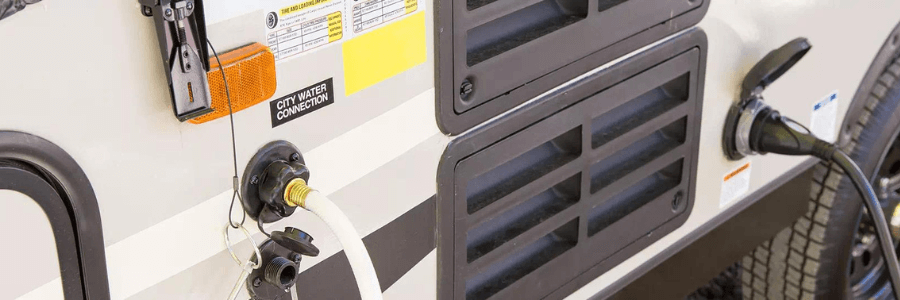5 Important Things You Need to Know About Your RV's Black Tank

If you’re a new owner of a motorhome or travel trailer, congratulations! Welcome to the RV life, a world of possibilities and your entryway to the great outdoors. While owning a residential vehicle comes with a lot of beauty and freedom waiting to be explored, there are inevitable aspects that require you to get down and dirty. Of these, the dirtiest is, by far, maintaining and emptying your RV’s black tank or septic system. While it isn’t the most glamorous job, it’s a necessary part of any RV adventure. And without proper maintenance and care of this system, things can get pretty ugly. Thankfully the team here at South Thompson RV has all the scoop on your RV’s poop chute. With these five tips, maintaining your black tank won’t have to be as dirty as you think!
1. Use the Two-Thirds Rule
How often you need to empty your tanks is relative. If you are travelling with a large number of people, you may need to empty your tanks every other day. If it is just you and your spouse, once a week may be enough. Most RVs have sensors that help monitor the levels in your black water, gray water, and freshwater holding tanks. Typically, the sensors track fluid levels in increments or percentages. A general rule of thumb is to wait until your tanks are about two-thirds full before emptying them. It creates a much better “flow” when dumping, making the process much more efficient.
2. Keep Dumping Supplies Handy
- Gloves: Disposable water-resistant gloves should be a part of everyone’s black tank kits. When you empty your tanks, you will most likely come in contact with unclean surfaces. Even when surfaces look clean, they might be dirtier than you think.
- Disinfectant spray and wipes: Keep your disinfectant spray and wipes handy while you empty your tanks. Even though you’ll want to wash your hands with soap and water after dumping, wipes can help you clean off sewer caps and other surfaces near the dump station, as well as provide a quick cleanup before washing your hands.
- RV sewer hose: Most RV sewer hoses have retractable accordion shells. The hoses stay relatively small during storage and stretch when it’s time to use. Sewer hose kits typically come with a 15-foot (4.5-metre) hose with swivel fittings and storage caps. If you need a hose with more length, consider purchasing an extension.
- Translucent elbow and adapter: A translucent elbow and adapter connect sewer hoses to dump station pipes. The clear elbow allows you to see when the liquid stops flowing, and the adapter helps attach the hose to different size threads on some dump station pipes.
- RhinoFlex Sewer Fitting Wrench: A sewer-fitting wrench wraps around the sewer hose and helps remove hard-to-budge hoses.
- Sewer Saddle Bag: The Sewer Saddle Bag is a gadget that straddles your sewer pipe and helps keep it in place when it’s time to empty your tank. Not all dump station pipes have working threads, and it’s sometimes hard to keep the sewer hose connected when it’s time to dump. For solo RVers who don’t have an extra hand — or foot — to hold the pipe in place, the Sewer Saddle Bag is a game changer.
- Storage solution: Some RVs have a built-in pipe or bumper designed to store sewer components. For RVers who need a portable sewer-hose storage solution, purchase an easy-to-identify storage bag.
3. Only Dump at Designated Dump Stations
Never dump your black tank’s wastewater anywhere except designated dump stations. Dump stations are always clearly marked, and many RVers rely on mobile RV apps to help them locate dump stations because apps typically have up-to-date closure and pricing information. Some dump stations, like some parks and campgrounds, operate seasonally, depending on temperatures. Apps often post real-time user experiences and provide contact numbers, so it’s easy to verify if a dump station is open or closed for the season.
4. Water is Your Best Friend
The one place you won’t want to conserve water is inside the black water holding tank. Water helps flush everything down better, and when mixed with a holding tank treatment, the water interacts with the treatment and breaks down RV toilet paper and solid waste. Before using the toilet, fill the bowl with water at least halfway. When you flush, everything should go down much easier.
5. Use RV toilet paper.
RVers often debate whether or not it’s necessary to use RV toilet paper. We have a whole blog on it, actually. Some people say that septic-friendly toilet paper is just as safe as RV toilet paper, but some manufacturers disagree. Your best bet? Stock your RV with the toilet paper the manufacturer suggests.
If you have more questions about maintaining your RV’s black tank, don’t hesitate to drop us a line at South Thompson RV for simple recommendations. You can also make an appointment with our service centre to ensure your RV is in tip-top shape and adventure-ready before hitting the road!